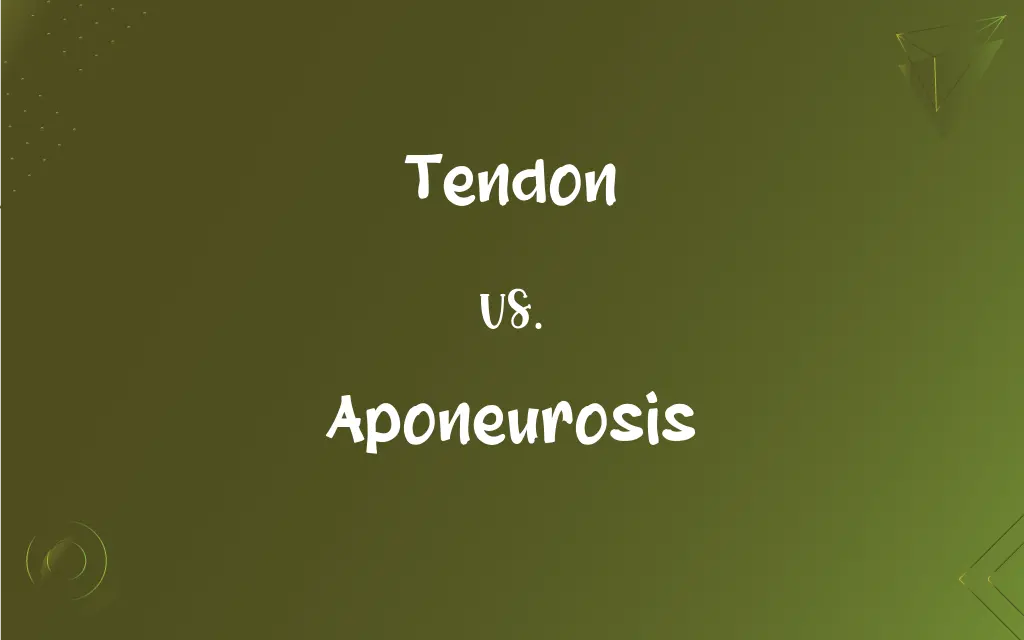Tendon vs. Aponeurosis: What's the Difference?
Edited by Aimie Carlson || By Janet White || Published on December 8, 2023
Tendon is a fibrous connective tissue attaching muscle to bone. Aponeurosis is a flat, broad tendon-like sheet connecting muscle to muscle or muscle to bone.

Key Differences
Tendons are cord-like structures made of collagen, connecting muscles to bones, transmitting the force from muscle contraction to the skeleton. However, aponeuroses are flat, sheet-like fibrous tissues, often serving as a fascia, connecting muscles to other muscles or bones, and providing a broad area for muscle attachment.
In function, tendons are designed for handling high tensile strength, enabling movement by transferring muscular force to bones. While, aponeuroses serve a similar function but are adapted for attaching to broader or flatter surfaces, distributing the force over a wider area.
Tendons are typically associated with specific, often smaller muscle-to-bone connections, like those in fingers. On the contrary, aponeuroses are found in areas requiring a wider, more diffuse attachment, such as the abdominal muscles attaching to the linea alba.
In terms of structure, tendons are more rope-like and cylindrical, while aponeuroses are flat and resemble a ribbon or a sheet. This structural difference reflects their respective roles in muscle attachment and force distribution.
Tendons are often more prone to injuries like tears or tendinitis due to their role in forceful, repetitive movements. In comparison, aponeuroses are less commonly injured but can be involved in strain injuries due to overuse or excessive stretching.
ADVERTISEMENT
Comparison Chart
Structure
Cord-like, cylindrical
Flat, sheet-like
Attachment
Connects muscle to bone
Connects muscle to muscle or muscle to bone
Function
Transfers force to bone
Distributes force over a wide area
Location in the Body
Common in limbs and smaller muscle groups
Found in larger, flatter muscle groups
Injury Susceptibility
More prone to tears and tendinitis
Less prone but can suffer from strains
ADVERTISEMENT
Tendon and Aponeurosis Definitions
Tendon
A collagen structure transmitting force from muscle to skeleton.
Injuries to the tendon can significantly impair movement.
Aponeurosis
A flat, broad connective tissue similar to a tendon.
The galea aponeurotica connects the frontal and occipital muscles.
Tendon
The tissue that enables joint movement by transferring muscle contractions.
She strained her tendon during the marathon.
Aponeurosis
A sheet-like fibrous tissue for muscle attachment.
The abdominal muscles are connected by the aponeurosis.
Tendon
A strong, fibrous connective tissue connecting muscle to bone.
The Achilles tendon attaches the calf muscle to the heel bone.
Aponeurosis
A wide, tendinous layer for muscle connection.
Her training focused on strengthening the aponeurosis for better core support.
Tendon
A key component in the musculoskeletal system for movement.
Tendons play a vital role in the flexibility of fingers.
Aponeurosis
Connects muscle to muscle or muscle to bone, distributing force.
Surgeons repaired the damaged aponeurosis in his shoulder.
Tendon
A band of tissue that anchors muscle to bone.
The bicep tendon is crucial for arm lifting motions.
Aponeurosis
An extensive, flat structure functioning like a tendon.
The lumbar aponeurosis contributes to lower back stability.
Tendon
A band of tough, inelastic fibrous tissue that connects a muscle with its bony attachment.
Aponeurosis
A sheetlike fibrous membrane, resembling a flattened tendon, that serves as a fascia to bind muscles together or as a means of connecting muscle to bone.
Tendon
(anatomy) A tough band of flexible but inelastic fibrous collagen tissue that connects a muscle with its bony attachment and transmits the force which the muscle exerts.
Aponeurosis
(anatomy) A flattened pearly white fibrous membrane taking the place of a tendon that binds together and forms the terminations and attachments of muscles or connects them to other body parts like skin or bone.
Tendon
(biology) The hamstring of a quadruped.
Aponeurosis
Any one of the thicker and denser of the deep fasciæ which cover, invest, and the terminations and attachments of, many muscles. They often differ from tendons only in being flat and thin. See Fascia.
Tendon
(construction) A wire or bar used to strengthen prestressed concrete.
Aponeurosis
Any of the deeper and thicker fascia that attach muscles to bones; resemble flattened tendons
Tendon
A tough insensible cord, bundle, or band of fibrous connective tissue uniting a muscle with some other part; a sinew.
Tendon
A cord or band of inelastic tissue connecting a muscle with its bony attachment
FAQs
What is the main function of a tendon?
To connect muscle to bone and transmit muscular force.
How does aging affect tendons?
Tendons can become less flexible and more prone to injury.
How is an aponeurosis different in structure from a tendon?
Aponeurosis is flat and sheet-like, while tendons are more cord-like.
What is an example of aponeurosis in the body?
The abdominal aponeurosis, connecting abdominal muscles.
Where are tendons commonly found?
In joints like the elbow, knee, and ankle.
Can aponeurosis be seen or felt?
It's not typically visible but can be palpated in some areas.
Can tendons stretch?
Yes, but they have limited elasticity.
Are tendon injuries common?
Yes, especially in athletes and those with repetitive stress movements.
What causes tendonitis?
Inflammation from overuse or injury leads to tendonitis.
What is the primary role of aponeurosis?
To attach muscles to other muscles or bones over a broad area.
How does exercise impact aponeurosis?
Regular exercise can strengthen and maintain its flexibility.
Does aponeurosis contribute to muscle strength?
Yes, by distributing force and aiding muscle function.
Do tendons contain blood vessels?
They have limited blood supply, which affects healing.
Can stretching benefit aponeurosis?
Yes, stretching helps maintain its elasticity and function.
Does aponeurosis vary in thickness?
Yes, depending on its location and function.
How do tendons heal?
Through rest and gradual physical therapy.
Is the aponeurosis essential in surgeries?
Yes, especially in reconstructive and orthopedic surgeries.
Is aponeurosis susceptible to surgical repair?
Yes, aponeurosis can be surgically repaired if damaged.
Are there diseases that affect tendons?
Conditions like rheumatoid arthritis can affect tendons.
What is tendon’s role in motion?
It transmits the force necessary for movement.
About Author
Written by
Janet WhiteJanet White has been an esteemed writer and blogger for Difference Wiki. Holding a Master's degree in Science and Medical Journalism from the prestigious Boston University, she has consistently demonstrated her expertise and passion for her field. When she's not immersed in her work, Janet relishes her time exercising, delving into a good book, and cherishing moments with friends and family.
Edited by
Aimie CarlsonAimie Carlson, holding a master's degree in English literature, is a fervent English language enthusiast. She lends her writing talents to Difference Wiki, a prominent website that specializes in comparisons, offering readers insightful analyses that both captivate and inform.







































































